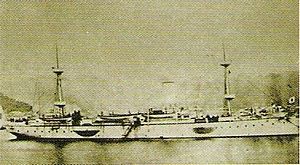Japanese cruiser Takao (1888)
Warning: Display title "Japanese cruiser <i>Takao</i> (1888)" overrides earlier display title "Japanese cruiser<i> Takao </i>(1888)" (help).
 Takao at Yokosuka, October 1889
| |
| History | |
|---|---|
| Name | Takao |
| Builder | Yokosuka Naval Arsenal |
| Laid down | 30 October 1886 |
| Launched | 15 October 1888 |
| Completed | 16 November 1889 |
| Stricken | 1 April 1911 |
| Fate | Scrapped, 27 March 1912 |
| General characteristics | |
| Type | Unprotected cruiser |
| Displacement | 1,750 long tons (1,778 t) |
| Length | 69.9 m (229.3 ft) |
| Beam | 10.4 m (34.1 ft) |
| Draught | 3.9 m (12.8 ft) |
| Installed power | 2,330 ihp (1,740 kW) |
| Propulsion | 2 shafts, 2 Horizontal compound steam engines, 5 boilers |
| Speed | 15 knots (28 km/h; 17 mph) |
| Complement | 220 |
| Armament | list error: <br /> list (help) 4 × 152 mm (6.0 in) L/35 Krupp guns 1 × QF 4.7 inch Gun Mk I–IV gun 1 × QF 6 pounder Hotchkiss gun 2 × quadruple 1-inch Nordenfelt guns 2 × 356 mm (14.0 in) torpedo tubes |
Takao (高雄) was an unprotected cruiser of the Imperial Japanese Navy. The name Takao comes from the Mount Takao, near Kyoto. Takao was used by the Imperial Japanese Navy primarily as an aviso or dispatch boat, for scouting, reconnaissance and the conveying of important messages.
Background
Takao was designed under the supervision of French military advisor Emile Bertin, and built in Japan by the Yokosuka Naval Arsenal, with many of its components imported from overseas. It was one of the first ships in Bertin’s project to introduce modern naval construction techniques to the Japanese, and a first step in the implementation of his Jeune Ecole naval strategy of using of small, heavily armed and lightly armored ships in naval warfare.[1] Due to its small size Takao is sometimes classified as a corvette or gunboat.
Design
Takao was a steel-ribbed and steel hulled vessel. It retained a full barque rigging with two masts for auxiliary sail propulsion in addition to hercoal-fired double-expansion reciprocating steam engine with single smoke stack and twin screws. The design incorporated a number of firsts for Japan, including a double hull amidships for additional protection, and the first Japanese built torpedo launchers. It was also the second warship to be built in Japan (after the gunboat Akagi) with an iron-rib and steel hull construction. Takao was armed with four 152 mm (6.0 in) L/35 Krupp guns mounted in sponsons as its main battery and had one stern-mounted QF 4.7 inch Gun Mk I–IVs gun and one QF 6 pounder Hotchkiss gun as its secondary battery. In addition, she had two quadruple 1-inch Nordenfelt guns and carried two torpedoes, mounted on the deck.[2]
Service record
Takao was laid down on 30 October 1886, launched on 15 October 1888 and completed on 16 November 1889. Her first captain was Commander Yamamoto Gonnohyōe.
Takao was active in the First Sino-Japanese War of 1894-1895, protecting troop transports to Korea, and covering the landing of Japanese forces at Port Arthur. It was subsequently involved in patrols of the Yellow Sea and was present at the Battle of Weihaiwei.[3]
In the year 1900, her rigging was removed, and her weaponry modernized.[4] Takao was assigned to assist in escorting transports supporting Japanese naval landing forces which occupied the port city of Tianjin in northern China during the Boxer Rebellion, as part of the Japanese contribution to the Eight-Nation Alliance, and subsequently patrolled the coasts off Amoy and Shanghai.
Considered obsolete by the time of the Russo-Japanese War of 1904-1905, Takao was assigned to rear guard patrols of Chemulpo harbor and Tsushima Strait, but was present with the rest of the Japanese fleet at the final decisive Battle of Tsushima.
The advent of wireless communication made the use of dispatch vessels obsolete, and Takao was removed from the navy list on 1 April 1911 [2] and was demilitarized and sold on 27 March 1912. She was used as a survey vessel until she was broken up in 1918.
References
- Chesneau, Roger (1979). Conway's All the World's Fighting Ships, 1860–1905. Conway Maritime Press. ISBN 0-85177-133-5.
- Evans, David C. (1997). Kaigun: Strategy, Tactics, and Technology in the Imperial Japanese Navy, 1887-1941. Annapolis, MD: Naval Institute Press. ISBN 0-87021-192-7.
{{cite book}}: Unknown parameter|coauthors=ignored (|author=suggested) (help) - Howarth, Stephen (1983). The Fighting Ships of the Rising Sun: The Drama of the Imperial Japanese Navy, 1895-1945. Atheneum. ISBN 0-689-11402-8.
- Jentsura, Hansgeorg (1976). Warships of the Imperial Japanese Navy, 1869-1945. Annapolis, MD: Naval Institute Press. ISBN 0-87021-893-X.
- Paine, S.C.M. (2003). The Sino-Japanese War of 1894-1895: Perception, Power, and Primacy. Cambridge, MA: Cambridge University Press. ISBN 0-521-61745-6.
- Roberts, John (ed). (1983). 'Warships of the world from 1860 to 1905 - Volume 2: United States, Japan and Russia. Bernard & Graefe Verlag, Koblenz. ISBN 3-7637-5403-2.
- Roksund, Arne (2007). The Jeune École: The Strategy of the Weak. Leiden: Brill. ISBN 978-90-04-15723-1.
- Schencking, J. Charles (2005). Making Waves: Politics, Propaganda, And The Emergence Of The Imperial Japanese Navy, 1868-1922. Stanford University Press. ISBN 0-8047-4977-9.
External links
Notes
- ^ Roksund, The Jeune École: The Strategy of the Weak;
- ^ a b Chesneau, Conway's All the World's Fighting Ships, 1860–1905, p. 234. Cite error: The named reference "Conway" was defined multiple times with different content (see the help page).
- ^ Paine, The Sino-Japanese War of 1894-1895: Perception, Power, and Primacy page 133-134
- ^ Jentsura, Warships of the Imperial Japanese Navy p. 92.
